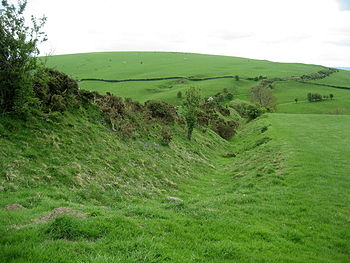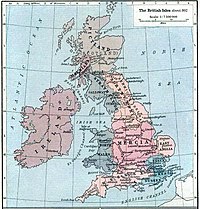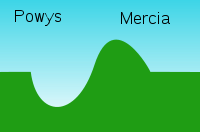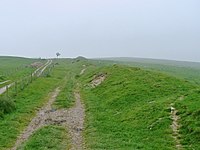Difference between revisions of "Offa's Dyke"
(Created page with 'Offa's Dyke near Clun '''Offa's Dyke''' ({{lang|cy|Clawdd Offa}}) is a massive linear earthwork running north-south in a line…') |
(→Overview) |
||
| Line 13: | Line 13: | ||
Offa was one of the great rulers of the Anglo-Saxon age, though his reign is often overlooked due to a limitation in source material. That he was able to raise a workforce and resources sufficient to construct such an earthwork as Offa's Dyke is testament to his power. It is likely that some form of 'service' system along the lines of corvée was used to construct the Dyke, with people from certain areas being required to build a certain length of the wall. This can be seen as additional to the normal services that had to be offered to kings. A document exists from around this period known as Tribal Hidage, which makes some assessment of how land was distributed in the 8th century. Though there is little evidence to associate the document with the Dyke, it is possible that both the Dyke and the document stem from a common practice. | Offa was one of the great rulers of the Anglo-Saxon age, though his reign is often overlooked due to a limitation in source material. That he was able to raise a workforce and resources sufficient to construct such an earthwork as Offa's Dyke is testament to his power. It is likely that some form of 'service' system along the lines of corvée was used to construct the Dyke, with people from certain areas being required to build a certain length of the wall. This can be seen as additional to the normal services that had to be offered to kings. A document exists from around this period known as Tribal Hidage, which makes some assessment of how land was distributed in the 8th century. Though there is little evidence to associate the document with the Dyke, it is possible that both the Dyke and the document stem from a common practice. | ||
| + | |||
| + | ==Historical evidence== | ||
| + | The late 9th- and early 10th-century writer Asser informed us that "there was in Mercia in fairly recent time a certain vigorous king called Offa, who terrified all the neighbouring kings and provinces around him, and who had a great dyke built between Wales and Mercia from sea to sea" (Asser, ''Life of Alfred'', p. .14). The last four words are vital: historians and archaeologists coming to the Dyke have had Asser in their hand, and have been looking for an earthwork 'from sea to sea'. Sir Cyril Fox completed the first major survey of the Dyke (Fox 1955), and, in agreement with Asser, theorised that the Dyke ran from the estuary of the [[River Dee]] in the north to the [[River Wye]] in the south (approximately 150 miles). He observed that the dyke was not continuous, and thought it was built only in areas where natural barriers did not already exist. | ||
| + | |||
| + | Frank Stenton, the eminent Anglo-Saxon historian of his day, accepted Fox's description, and wrote the introduction to Fox's account of the Dyke. Though Fox's work has now been to some extent revised, it remains a vital record of stretches of the Dyke that still existed between 1926 and 1928, when his three field surveys took place, but that are now destroyed. | ||
| + | |||
| + | ==Modern scholarship== | ||
| + | Frank Noble challenged Fox's legacy. His greatest contribution was to stir up new academic interest in Offa's Dyke. His MPhil thesis, "Offa's Dyke Reviewed" (1978), raised several questions. Noble postulated that the gaps in the Dyke were not due to natural features, but that instead a "ridden boundary" operated, perhaps incorporating palisades that left no archaeological trace. Noble also helped establish the Offa's Dyke Association, which maintains the [[Offa's Dyke Path]]. This long distance footpath mostly follows the route of the dyke, which is one of the designated British National Trails. | ||
| + | |||
| + | Ongoing research and archaeology on Offa's Dyke has been undertaken for many years by the Extra-Mural department of the [[University of Manchester]]. Most recently David Hill and Margaret Worthington have undertaken considerable research on the Dyke. Their work, though far from finished, has demonstrated that there is little evidence for the Dyke's stretching from sea to sea. Rather, they claim that it is a shorter structure stretching from [[Rushock Hill]] north of the [[Herefordshire]] Plain to [[Llanfynydd, Flintshire|Llanfynydd]], near [[Mold]] in [[Flintshire]], some 64 miles. According to Hill and Worthington, dykes in the far north and south may have different dates, and though they may be connected with Offa's Dyke, there is as yet no compelling evidence behind this. However, not all experts accept this view.<ref>[http://www.cpat.org.uk/offa/offrev.htm Ian Bapty review of Hill and Worthington, ''Offa's Dyke: History and Guide'', 2003]</ref> | ||
| + | |||
| + | ==Alternative theories== | ||
| + | The Roman historian Eutropius in his book, ''Historiae Romanae Breviarium'', written around 369, mentions the Wall of Severus, a structure built by Septimius Severus who was Roman Emperor between 193 and 211: | ||
| + | <blockquote> | ||
| + | ''Novissimum bellum in Britannia habuit, utque receptas provincias omni securitate muniret, vallum per CXXXIII passuum milia a mari ad mare deduxit. Decessit Eboraci admodum senex, imperii anno sexto decimo, mense tertio.'' [http://www.forumromanum.org/literature/eutropius/text8.html#19 ''Historiae Romanae Breviarium, viii 19.1''] | ||
| + | |||
| + | He had his most recent war in Britain, and to fortify the conquered provinces with all security, he built a wall for 133 [Roman] miles from sea to sea. He died at York, a reasonably old man, in the sixteenth year and third month of his reign. | ||
| + | </blockquote> | ||
| + | |||
| + | This source is conventionally thought to be referring, in error, to either [[Hadrian's Wall]] (73 modern miles) or the [[Antonine Wall]] (37 modern miles), which were both much shorter and built in the 2nd century.<ref>{{cite book | last=Smith | first=William | title=Dictionary of Greek and Roman Antiquities | publisher=John Murray | year=1875 | location=London | pages=762 }}.</ref> Bede referred to hadrian's Wall as the Wall of Severus. Most archaeologists reject the theory that Eutropius was referring to an early Offa's Dyke.<ref>[http://www.cpat.org.uk/news/oldnews/offaro.htm CPAT: New book claims that Offa's Dyke is Roman!, article by Ian Bapty]</ref><ref>{{cite web|url=http://www.cpat.org.uk/offa/what.htm|title=What is Offa's Dyke?|publisher=The Clwyd-Powys Archaeological Trust|date=16 October 2009}}</ref><ref>{{cite web|url=http://www.badarchaeology.net/confused/wall_of_severus.php|first=Keith|last=Matthews|title=Was Offa's Dyke actually the 'Wall of Severus'}}</ref> | ||
Revision as of 21:19, 13 January 2014
Offa's Dyke (Welsh: Clawdd Offa) is a massive linear earthwork running north-south in a line once perhaps 150 miles, roughly followed the boundary between England with Wales, which it was designed during the Dark Ages to mark border. In places, it is up to 65 feet wide (including its flanking ditch) and 8 feet high.
The work is a defensive earthwork, consisting of a classic bank and ditch. The ditch is to the west, showing it to have been built to defend the Mercian side to the east.
The dyke was created in the 8th century to form a delineation between the English kingdom of Mercia and the Welsh kingdom of Powys. It is attributed to King Offa, under whom Mercia reached the pinnacle of its power.
Overview
It is generally accepted that much of the earthwork can be attributed to Offa, King of the Mercians from 757 to 796. Its is dug as a bank and ditch, the displaced soil piled into a bank on the Mercian (eastern) side, to produce a formidable barrier against attack from the west. Where the earthwork encounters hills, it passes to the west of them, constantly providing an open view from Mercia into Wales. The dyke is in form a defensive earthwork, and a political statement of power, as well as a practical boundary marker emplaced after centuries of warfare and shifting boundaries.
Offa was one of the great rulers of the Anglo-Saxon age, though his reign is often overlooked due to a limitation in source material. That he was able to raise a workforce and resources sufficient to construct such an earthwork as Offa's Dyke is testament to his power. It is likely that some form of 'service' system along the lines of corvée was used to construct the Dyke, with people from certain areas being required to build a certain length of the wall. This can be seen as additional to the normal services that had to be offered to kings. A document exists from around this period known as Tribal Hidage, which makes some assessment of how land was distributed in the 8th century. Though there is little evidence to associate the document with the Dyke, it is possible that both the Dyke and the document stem from a common practice.
Historical evidence
The late 9th- and early 10th-century writer Asser informed us that "there was in Mercia in fairly recent time a certain vigorous king called Offa, who terrified all the neighbouring kings and provinces around him, and who had a great dyke built between Wales and Mercia from sea to sea" (Asser, Life of Alfred, p. .14). The last four words are vital: historians and archaeologists coming to the Dyke have had Asser in their hand, and have been looking for an earthwork 'from sea to sea'. Sir Cyril Fox completed the first major survey of the Dyke (Fox 1955), and, in agreement with Asser, theorised that the Dyke ran from the estuary of the River Dee in the north to the River Wye in the south (approximately 150 miles). He observed that the dyke was not continuous, and thought it was built only in areas where natural barriers did not already exist.
Frank Stenton, the eminent Anglo-Saxon historian of his day, accepted Fox's description, and wrote the introduction to Fox's account of the Dyke. Though Fox's work has now been to some extent revised, it remains a vital record of stretches of the Dyke that still existed between 1926 and 1928, when his three field surveys took place, but that are now destroyed.
Modern scholarship
Frank Noble challenged Fox's legacy. His greatest contribution was to stir up new academic interest in Offa's Dyke. His MPhil thesis, "Offa's Dyke Reviewed" (1978), raised several questions. Noble postulated that the gaps in the Dyke were not due to natural features, but that instead a "ridden boundary" operated, perhaps incorporating palisades that left no archaeological trace. Noble also helped establish the Offa's Dyke Association, which maintains the Offa's Dyke Path. This long distance footpath mostly follows the route of the dyke, which is one of the designated British National Trails.
Ongoing research and archaeology on Offa's Dyke has been undertaken for many years by the Extra-Mural department of the University of Manchester. Most recently David Hill and Margaret Worthington have undertaken considerable research on the Dyke. Their work, though far from finished, has demonstrated that there is little evidence for the Dyke's stretching from sea to sea. Rather, they claim that it is a shorter structure stretching from Rushock Hill north of the Herefordshire Plain to Llanfynydd, near Mold in Flintshire, some 64 miles. According to Hill and Worthington, dykes in the far north and south may have different dates, and though they may be connected with Offa's Dyke, there is as yet no compelling evidence behind this. However, not all experts accept this view.[1]
Alternative theories
The Roman historian Eutropius in his book, Historiae Romanae Breviarium, written around 369, mentions the Wall of Severus, a structure built by Septimius Severus who was Roman Emperor between 193 and 211:
This source is conventionally thought to be referring, in error, to either Hadrian's Wall (73 modern miles) or the Antonine Wall (37 modern miles), which were both much shorter and built in the 2nd century.[2] Bede referred to hadrian's Wall as the Wall of Severus. Most archaeologists reject the theory that Eutropius was referring to an early Offa's Dyke.[3][4][5]Novissimum bellum in Britannia habuit, utque receptas provincias omni securitate muniret, vallum per CXXXIII passuum milia a mari ad mare deduxit. Decessit Eboraci admodum senex, imperii anno sexto decimo, mense tertio. Historiae Romanae Breviarium, viii 19.1
He had his most recent war in Britain, and to fortify the conquered provinces with all security, he built a wall for 133 [Roman] miles from sea to sea. He died at York, a reasonably old man, in the sixteenth year and third month of his reign.
- ↑ Ian Bapty review of Hill and Worthington, Offa's Dyke: History and Guide, 2003
- ↑ Smith, William (1875). Dictionary of Greek and Roman Antiquities. London: John Murray. pp. 762..
- ↑ CPAT: New book claims that Offa's Dyke is Roman!, article by Ian Bapty
- ↑ "What is Offa's Dyke?". The Clwyd-Powys Archaeological Trust. 16 October 2009. http://www.cpat.org.uk/offa/what.htm.
- ↑ Matthews, Keith. "Was Offa's Dyke actually the 'Wall of Severus'". http://www.badarchaeology.net/confused/wall_of_severus.php.



